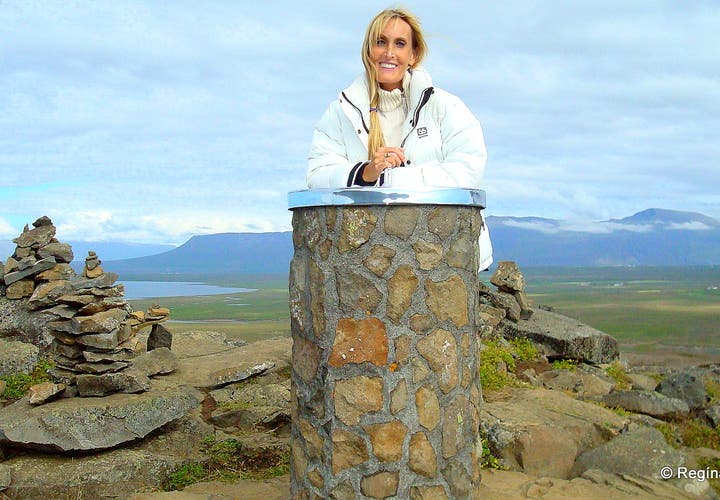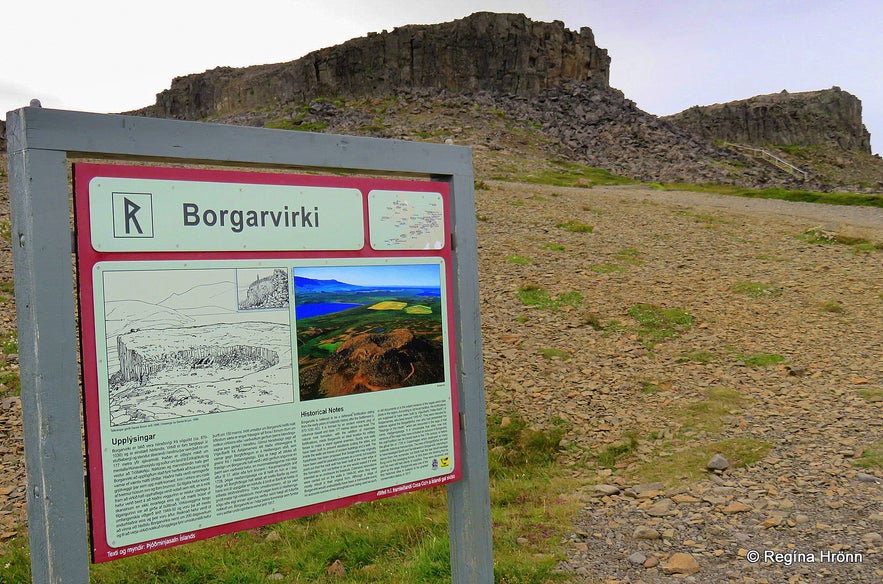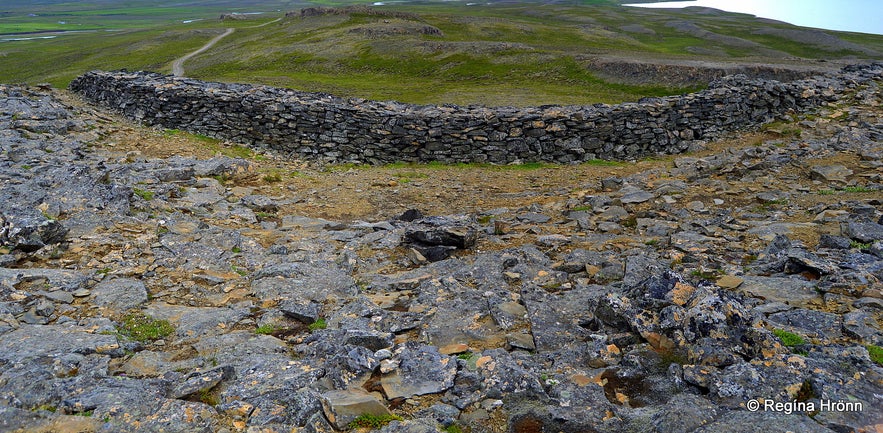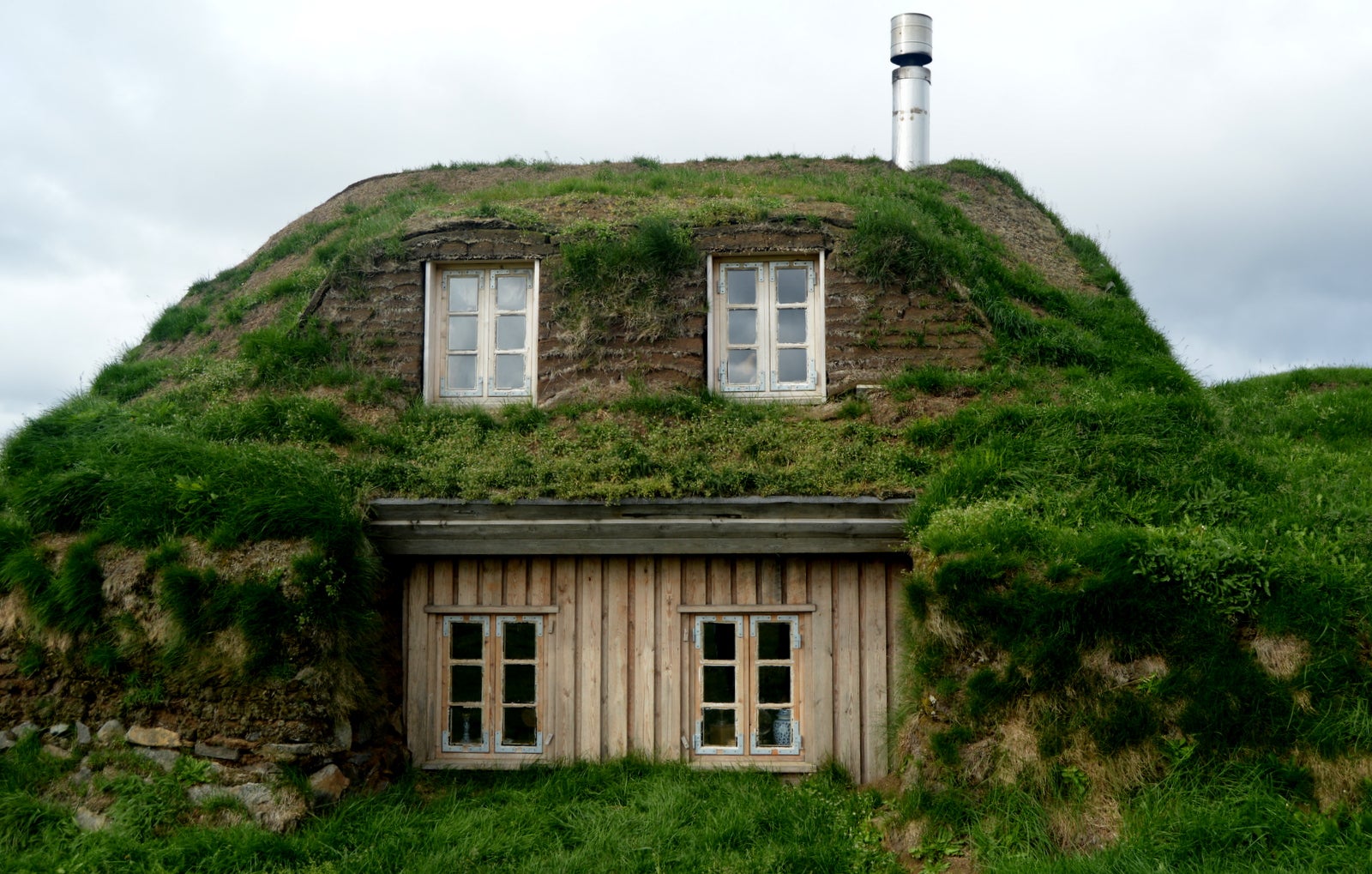Borgarvirki - the Citadel is a columnar basalt fortress and a volcanic plug on the Vatnsnes peninsula in northwest Iceland. It is 10-15 m high and 177 meters above sea level.
It might have been used as an old Viking fortress, at least some legends claim that it was, but we don't know this for sure.
Top photo: The information sign by Borgarvirki
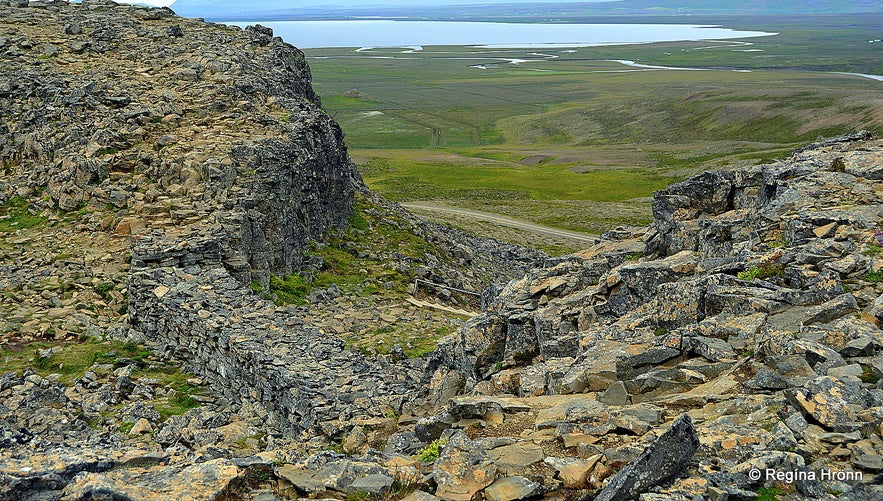
Inside Borgarvirki
I go with the notion that it is a Viking fortress, but that is only because I love to find Viking stuff in my country ;)
Steps lead up to the top of Borgarvirki. It is very rocky here, and a lot of rocks have fallen from the fortress. But as you reach the top of the fortress, the view from here is breathtaking.
There is a hollow dent in the middle of the fortress about 5-6 meters deep, and you can see that man-made walls of stones from the fortress have been built there with an opening to the east.
Parts of the walls of stones and the entrance were reconstructed back in 1949-1950.
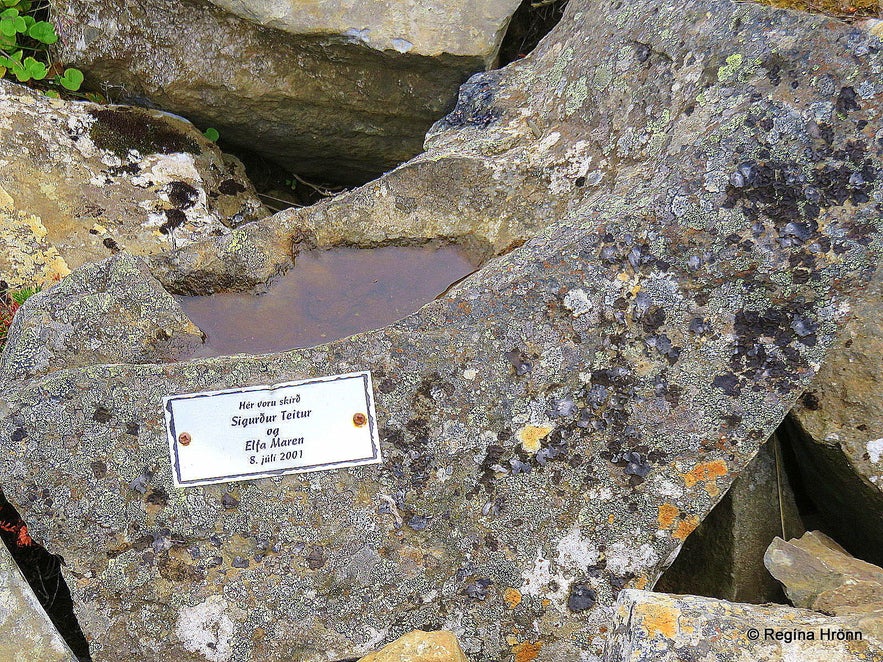
Here were baptized Sigurður Teitur and Elfa Maren
Once inside Borgarvirki, you will notice a stone with a plate on it saying: "Hér voru skírð Sigurður Teitur og Elfa Maren 8. júlí 2001" or in English: "Sigurður Teitur and Elfa Maren were baptized here on the 8th of July 2001".
Inside the fortress, you will see the remains of 2 ruins of huts from ancient times. And a waterhole.
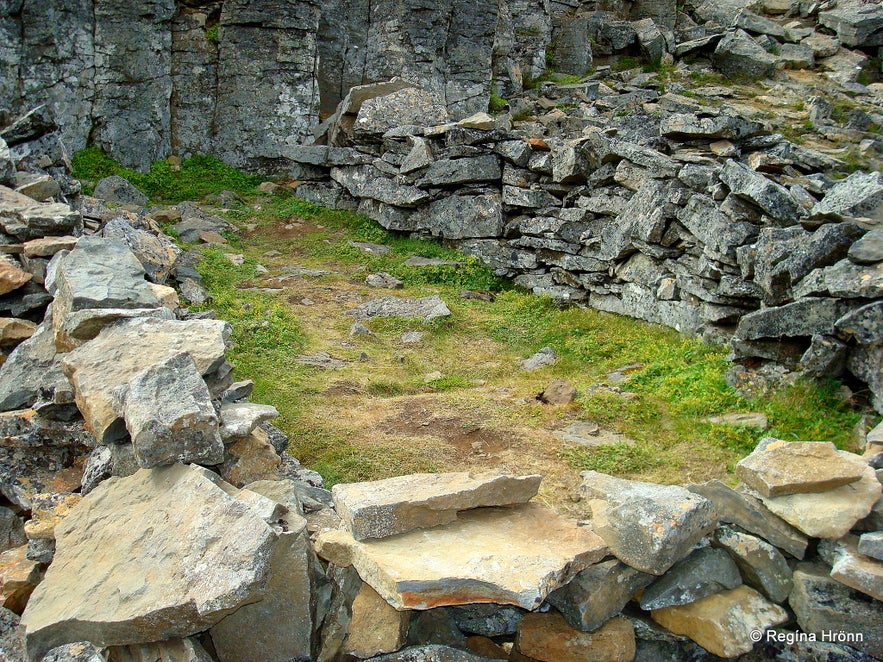
Inside Borgarvirki
According to Þjóðsögur Jóns Árnasonar - the Compilation of Folklore of Jón Árnason, which I refer to very often in my travel-blogs, the people of this area, Húnavatn district, used Borgarvirki as a defense when the chieftains of Borgarfjörður attacked them in the 11th century.
This was during the Heiðarvíga killings.
The Heiðarvígasaga - the Saga of the Heath Slayings, and the only copy of it, burnt in a tragic fire in 1728 in Copenhagen, where many valuable manuscripts were lost. It is such a great loss.
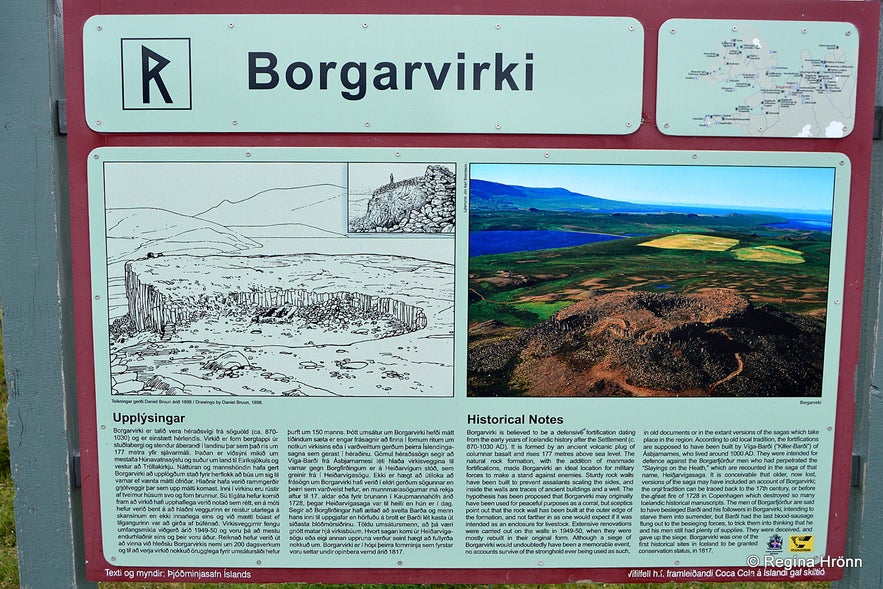
The information sign at Borgarvirki
The scholar Jón Ólafsson from Grunnavík rewrote parts of the Heiðarvíga Saga from memory, but he had copied Heiðarvíga Saga more than a year earlier from an old manuscript.
I have read the Heiðarvíga Saga, and it is an interesting story about both Víga-Styr from the Snæfellsnes peninsula and Víga-Barði from Vatnsnes.
Víga-Barði was the grandson of Ólafur pá from the Laxdæla Saga and the great-grandson of Egill Skallagrímsson from the Saga of Egill.
This legend of the Borgarvirki fortress might have been in an older version of the Heiðarvíga Saga, we don't know, so it stays a legend.
Inside Borgarvirki
According to the legend, which I found in Þjóðsögur Jóns Árnasonar - the Compilation of Folklore of Jón Árnason, the people of the Húnavatn district were under siege, and the attackers' strategy was to starve them out.
On one occasion, they had run out of food.
They overheard that their enemies were talking about how much provision they had left.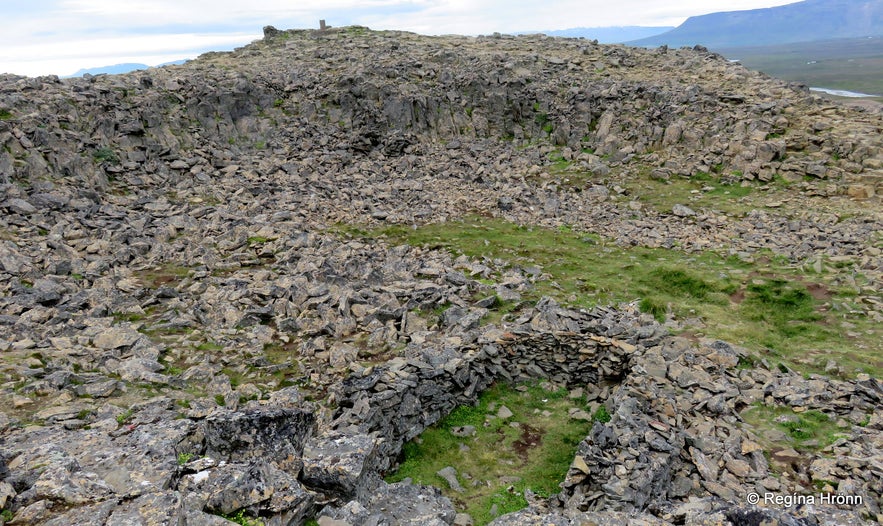
Inside Borgarvirki
I translated the whole account for you into English, as I think that it is very interesting:
"Not far from the farm Stóraborg in Vesturhóp, you will find a tall and large cliff on a hill or a ridge west of Víðidalsá river; this cliff is called Borg, like the farm, or Borgarvirki.
On the north and west side, the cliff is not lower than ten fathoms tall, created by natural pentagonal (fimmstrendu) columnar basalt; on the south side, the natural fortress has been much lower, but the ancients stacked the fence with such large rocks that five or six men could barely move them around.
The same goes for the east side of the fortress, where the entrance was, but the doors have collapsed.
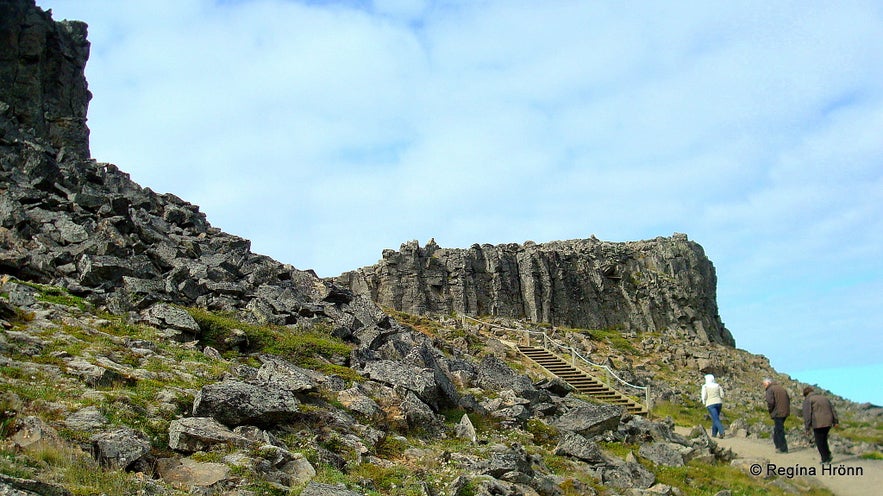
The steps leading to Borgarvirki
The fortress is 200 fathoms in perimeter with a great view, and the fortress can be seen from afar. Inside the fortress are a small grassy dell and a wellspring. Ruins of small huts can still be seen.
Seeing that nobody seems to know for sure who built this fortress, i.e. the parts which have been stacked, those who have written about the fortress guess that it might have been built by Finnbogi rammi, while he was living at Borg.
This he might have done as a defense from the warfare of Vatnsdælir, even though this is neither mentioned in the Saga of Vatnsdælir nor the Saga of Finnbogi rammi.
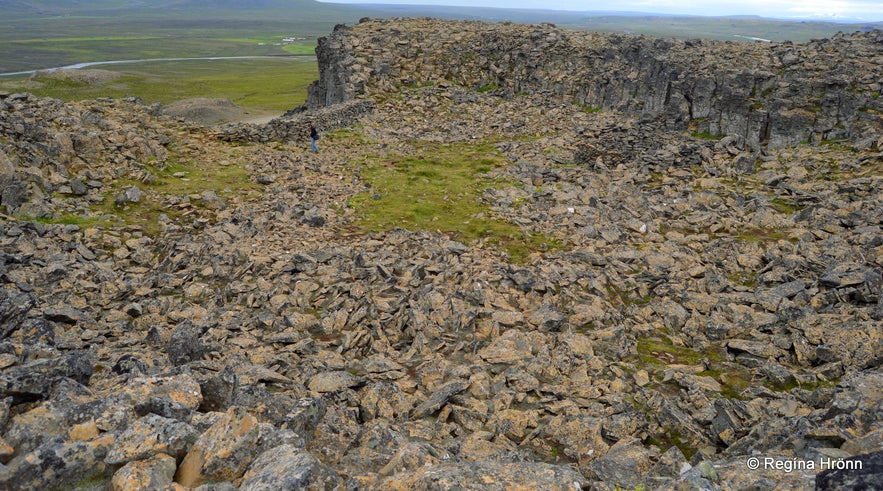
Inside Borgarvirki
Or it might have been Barði Guðmundsson (Víga-Barði) from Ásbjarnarnes who built it as a defense for himself and his men against the Borgfirðingar (people from Borgarfjörður) after the Heiðarvígin killings.
Unfortunately, parts of Heiðarvíga Saga are missing, and no perfect copy is available to prove this. This story might have been told in an older version of the Heiðarvíga Saga.
But folklore, both new and old, at least from the days of Páll Vídalín and to this day, straight out tells us that Barði, which usually is called Víga-Barði, and his men built Borgarvirki.
The folklore warrants that this has been written and should be written in Heiðarvíga Saga.
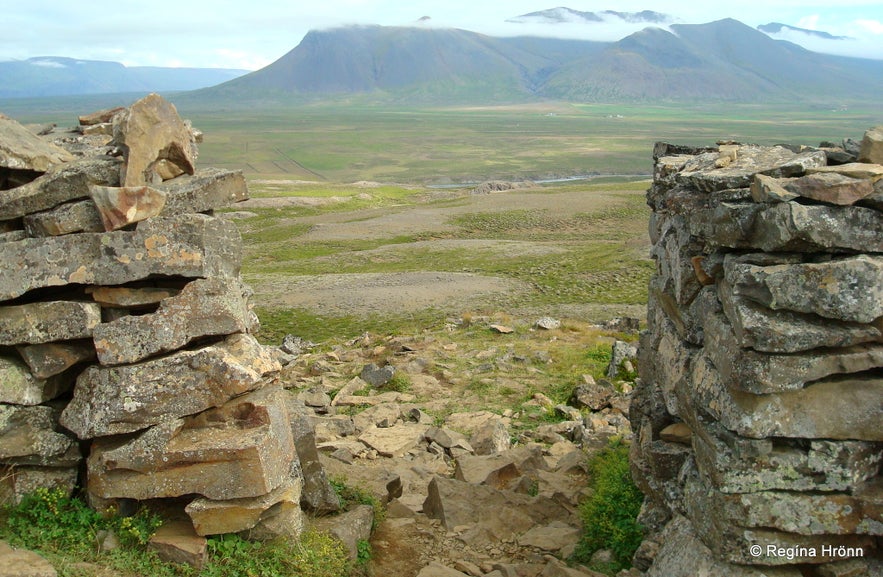
Inside Borgarvirki, looking out
After Víga-Barði and his men had had their revenge on the Borgfirðingar, to revenge Hallur, the brother of Víga-Barði, folklore says that Barði built this fortress as he expected that the Borgfirðingar would go north to seek revenge for the loss of life they had suffered by Norðlendingar (the northerners) in the Heiðarvíga killings.
Barði not only built the fortress, but he also placed men in two places, one at Þóreyjarnúpur in case the Borgfirðingar would take the Tvídægra route, and the other one by Rauðanúpur, in case they would choose the Arnarvatnsheiði route, to Víðidalur or Vatnsdalur valleys.
These scouts should light a fire if they were to spot the Borgfirðingar.

Borgarvirki
Barði‘s hunch was accurate as the Borgfirðingar showed up, but the route from the south is not mentioned.
Then Barði went to the fortress with his men, and the Borgfirðingar beleaguered the fortress and unsuccessfully attacked it a couple of times.
The Borgfirðingar then planned on starving their enemies inside the fortress, but one legend says that Barði and his men had had ample supplies, and the Borgfirðingar had returned home after 2 weeks of siege.
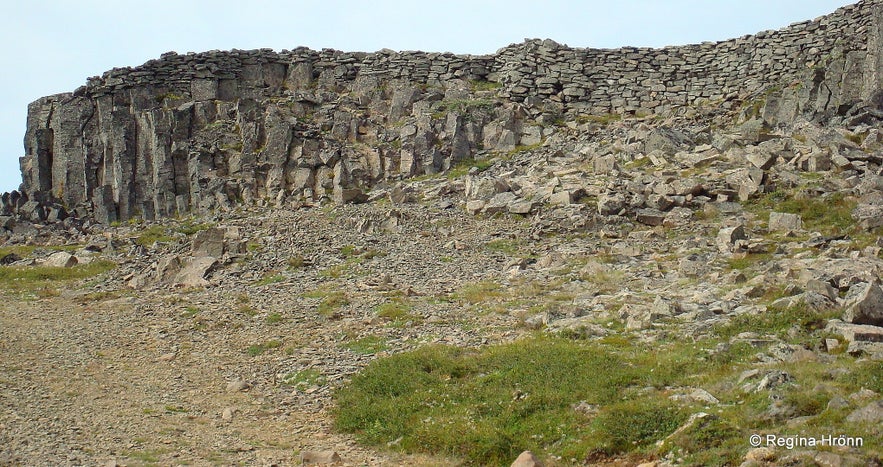
Borgarvirki
Others tell the story differently, and this version was also common while Páll Vídalín was alive, that the men in the fortress had so little food left before the Borgfirðingar returned home that the only food they had left was one "mörsiður", which is sheep fat or suet.
But the last time that the Borgfirðingar attacked the fortress, one of the men inside the fortress had thrown "mörsiður" and rocks at the Borgfirðingar party in defense.
The Borgfirðingar gathered that there were ample provisions in the fortress and left.
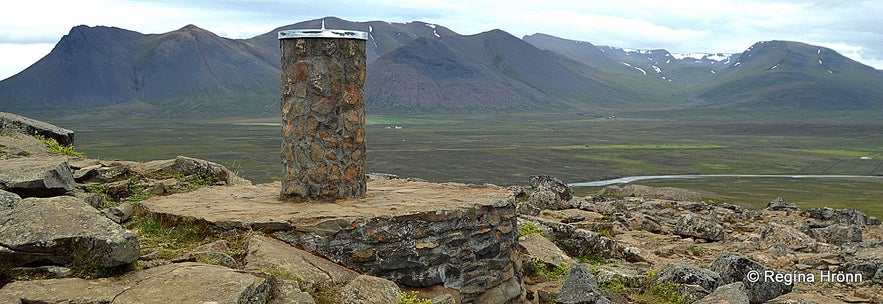
The view dial at Borgarvirki
But legend has it up north that Víga-Barði had once noticed that the Borgfirðingar outside the fortress were discussing amongst themselves that the men inside the fortress would soon be lacking provisions.
Barði then called one of his men (bryti) and asked him to show him how much provision they had left.
The man brought the "mörsiður" - and told him that this was the only food they had left.
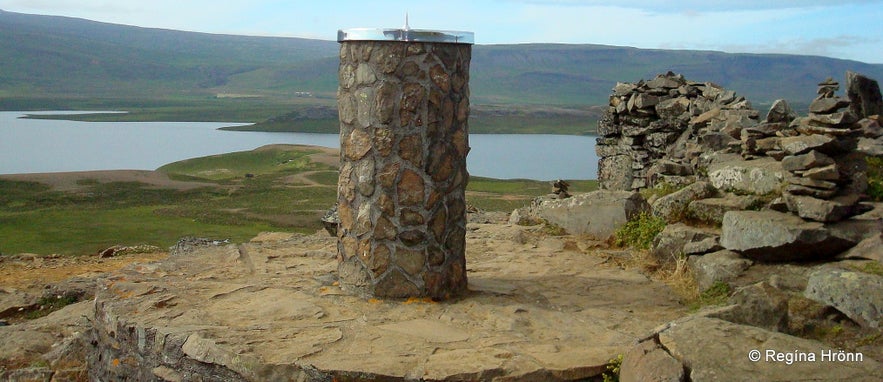
The view dial at Borgarvirki
Barði then cut the "mörsiður“ in half and threw both pieces across the fortress wall into the crowds of Borgfirðingar, where they stood and were discussing the lack of provisions of their enemies.
After Barði‘s trick, the Borgfirðingar returned south, gathering that the men inside the fortress had ample food supplies.
The same proverb is connected to these two stories: "að kasta út mörsiðrinu“ or to throw away the fat (suet)."
(Translated into English from Borgarvirki and Víga-Barði in Þjóðsögur Jóns Árnasonar - I was lacking a couple of terms in English - RHR)
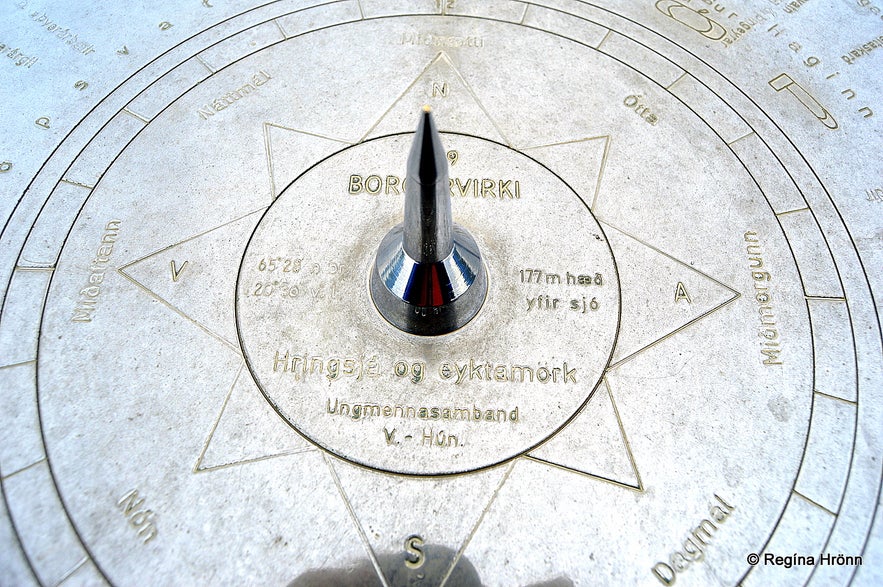
The view dial on top of Borgarvirki
On top of Borgarvirki, you will find a view dial showing the names and heights of the mountains in the vicinity.
There are around 90+ view-dials in Iceland, and my goal is to find most of them and photograph them.
My father-in-law, Jakob Hálfdanarson, designed this view dial back in 1988, and it was erected in 1990 by Ungmennafélag Vestur-Húnavatnssýslu. If you look closely during your visit, you will see his initials J.H. on the view dial.
I have written another travel-blog about the view-dials in the Westfjords.
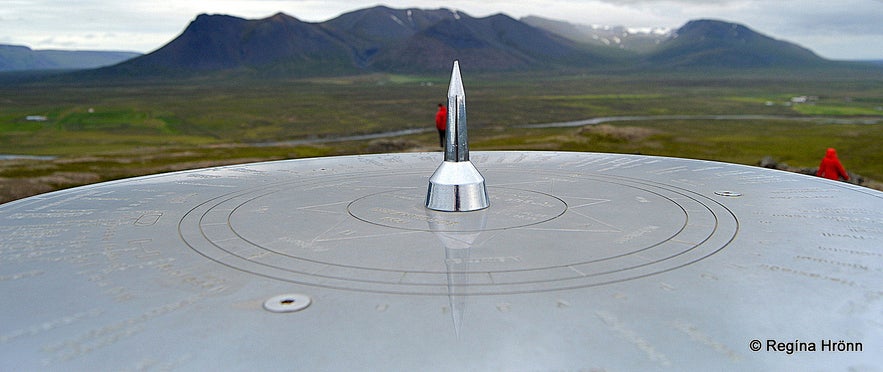
The view dial on top of Borgarvirki
Even though it was July during my visit, I am dressed in layers and wearing a down parka from 66° North, which is our best-known Icelandic brand.
It is an expensive brand, but when they are having a sale at their outlet, we Icelanders flock to the outlet and stock up on clothes that fit the Icelandic weather.
The Icelandic summers are not warm, so a parka is needed most of the time when travelling around Iceland in the summertime.
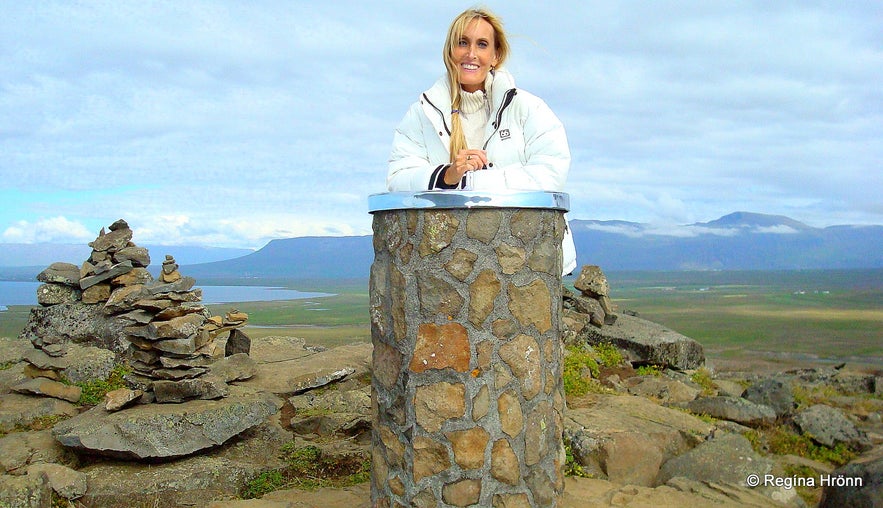
By the view dial on top of Borgarvirki
To reach Borgarvirki from Hvítserkur monolith, you drive on road 711 and turn left on 717, which is 8 km of a bad one-lane road with hard shoulders and several blind hills.
The road seems never-ending, and when we finally got up to the parking lot by Borgarvirki on one of our visits there, we saw a tank lorry coming in our direction. We counted our blessings that we "missed" it by a few minutes. So please drive carefully here.
The photo below shows what the gravel road looks like, and the lower sign is the sign for the view dial - called hringsjá in Icelandic.

Notice the sign with the two men and a view dial between them - this is the view dial sign
To get back to ring-road 1, you drive further on road 717, which turns into 716 and leads you to ring-road 1.
It is a bit tricky getting to Borgarvirki, but it is so worth it.
You can either rent a car in Reykjavík and drive to Borgarvirki or join this guided tour Wild North Super Jeep Tour | Grábrók Crater, Kolugljúfur Canyon & Borgarvirki Citadel.
This is the only guided tour that I have found of this area.
I have written other travel-blogs about interesting things to see and do in the vicinity of Borgarviki:
Hvítserkur monolith on the Vatnsnes peninsula
A lovely Stay at Dæli by Kolugljúfur Canyon in North Iceland
The historical Þingeyrakirkja Church in North Iceland - one of Iceland's most beautiful Churches
Have a lovely time on the Vatnsnes peninsula :)

